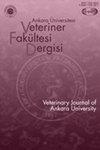福斯克林和PGE2对山羊黄体早期和晚期黄体细胞合成黄体酮的影响
IF 0.9
4区 农林科学
Q3 VETERINARY SCIENCES
引用次数: 0
摘要
本研究的目的是研究福斯克林和PGE2对早期和晚期黄体培养的山羊黄体细胞类固醇合成的影响。因此,将从黄体两期取出的黄体细胞与新生牛犊血清一起培养18小时,然后更换培养基,在新鲜培养基中加入不同浓度的福斯克林(10、100ng/ml)或PGE2(10、100ng/ml)再培养96小时。每48小时更换一次培养基,取出的培养基在-20℃冷冻,直到进行激素分析。在黄体早期和晚期,与对照组相比,经福斯克林处理的黄体细胞以剂量依赖的方式产生更高的黄体酮。与对照组相比,低剂量PGE2在黄体晚期增加了黄体细胞的黄体酮分泌,而在早期没有增加。与对照组相比,高剂量PGE2对山羊黄体早期和晚期黄体酮合成无显著影响。因此,本山羊研究表明,福斯克林促进黄体早期和晚期黄体细胞的孕酮合成,而PGE2仅在晚期低剂量处理的细胞中有效。本文章由计算机程序翻译,如有差异,请以英文原文为准。
Effects of forskolin and PGE2 on progesterone synthesis by goat luteal cells at early and late stages of corpus luteum
The aim of this research was to examine the effects of forskolin and PGE2 on steroid synthesis in goat luteal cells cultured at early and late corpus luteum. Therefore, the luteal cells removed from both stage of corpus luteum were cultured with newborn calf serum for the first 18 h. Then, media was changed and different concentrations of forskolin (10, 100ng/ml) or PGE2 (10, 100ng/ml) were added to the fresh media for another 96 h. The culture media was replaced every 48 h and the retrieved media was kept frozen at -20 °C until hormone analysis. Luteal cells treated with forskolin produced a higher production of progesterone in a dose-dependent manner, compare to the control well at early and late stage of corpus luteum. Lower dose of PGE2 increased the progesterone secretion in luteal cells compare to the control groups at the late stage of corpus luteum but not at early stage. The cells treated with higher dose of PGE2 had no significant effect on progesterone synthesis at early and late phase of goat corpus luteum in comparison to control groups. As a result, this study in goat shows that forskolin promotes progesterone synthesis of the luteal cells at the early and late corpus luteum, but PGE2 is only effective in cells treated with low dose at the late stage.
求助全文
通过发布文献求助,成功后即可免费获取论文全文。
去求助
来源期刊
CiteScore
1.50
自引率
0.00%
发文量
44
审稿时长
6-12 weeks
期刊介绍:
Ankara Üniversitesi Veteriner Fakültesi Dergisi is one of the journals’ of Ankara University, which is the first well-established university in the Republic of Turkey. Research articles, short communications, case reports, letter to editor and invited review articles are published on all aspects of veterinary medicine and animal science. The journal is published on a quarterly since 1954 and indexing in Science Citation Index-Expanded (SCI-Exp) since April 2007.

 求助内容:
求助内容: 应助结果提醒方式:
应助结果提醒方式:


